Abstract
1. Topical application of capsaicin to the human nasal mucosa induced a burning sensation and sneezing. A dose-dependent seromucous nasal secretion was also observed. Capsaicin (75 micrograms) was more potent than methacholine (50 mg) in producing nasal secretion, while topical histamine (200 micrograms), substance P (135 micrograms) and calcitonin gene-related peptide (36 micrograms) did not induce rhinorrhea. 2. Pretreatment with either topical ipratropium bromide, systemic dexchlorpheniramine or indomethacin did not influence the effects induced by capsaicin. Topical pretreatment with lidocaine inhibited the painful sensation but failed to block the rhinorrhea. Desensitization to the effects of capsaicin occurred following 4-5 subsequent applications, and full recovery was observed within 30-40 days. 3. It is proposed that the effects of capsaicin in human nasal mucosa are due to excitation of primary afferent neurones that (a) convey burning and painful sensation, (b) evoke a sneezing reflex and (c) induce nasal secretion by releasing transmitter(s) from their peripheral terminals.
Full text
PDF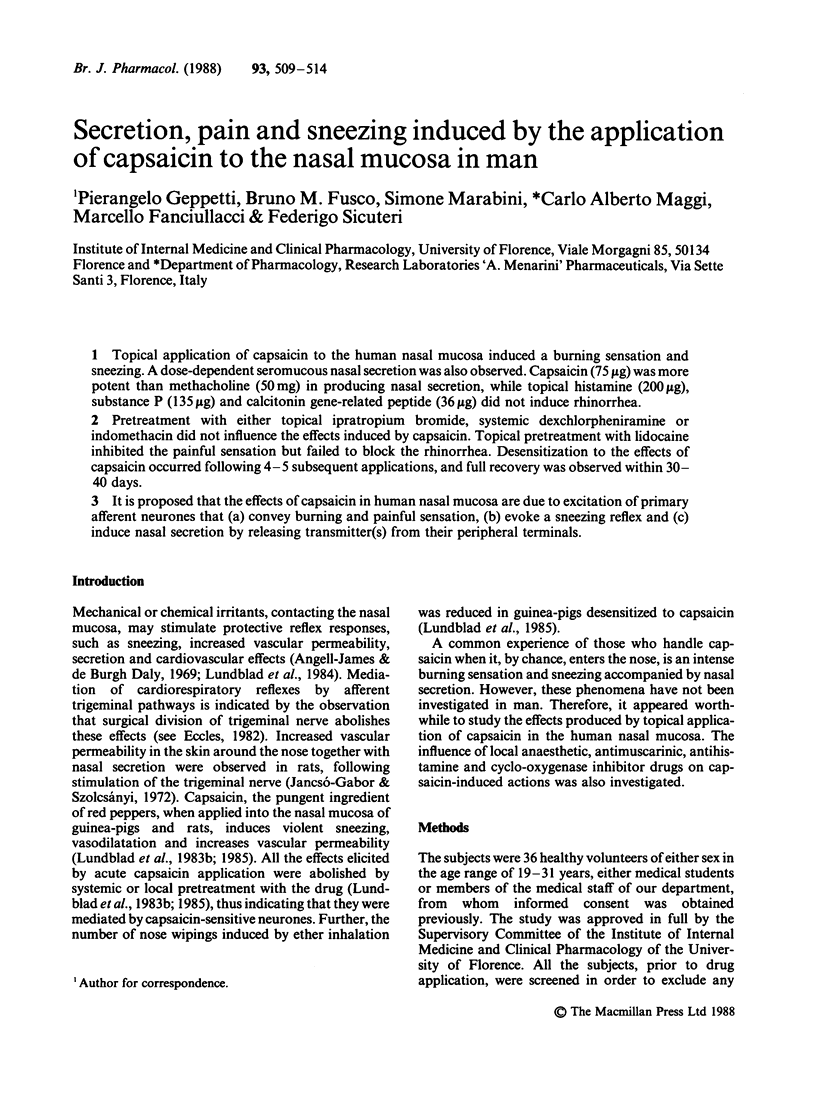
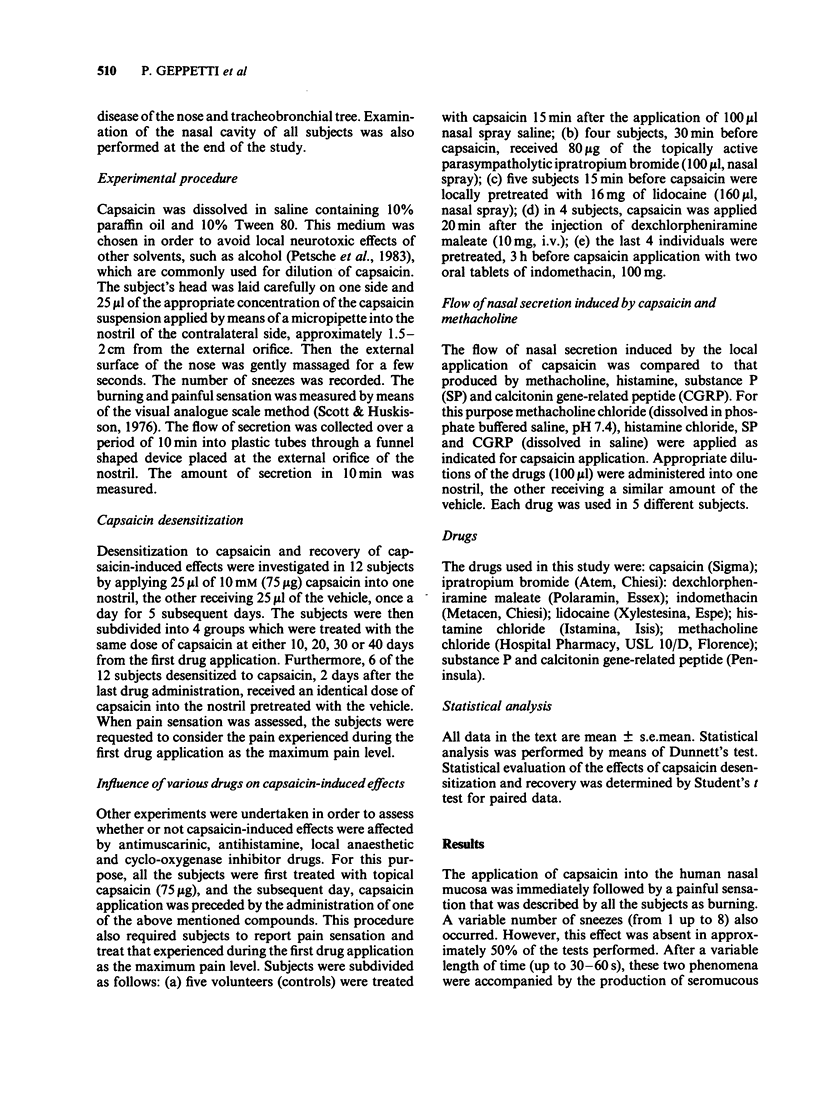
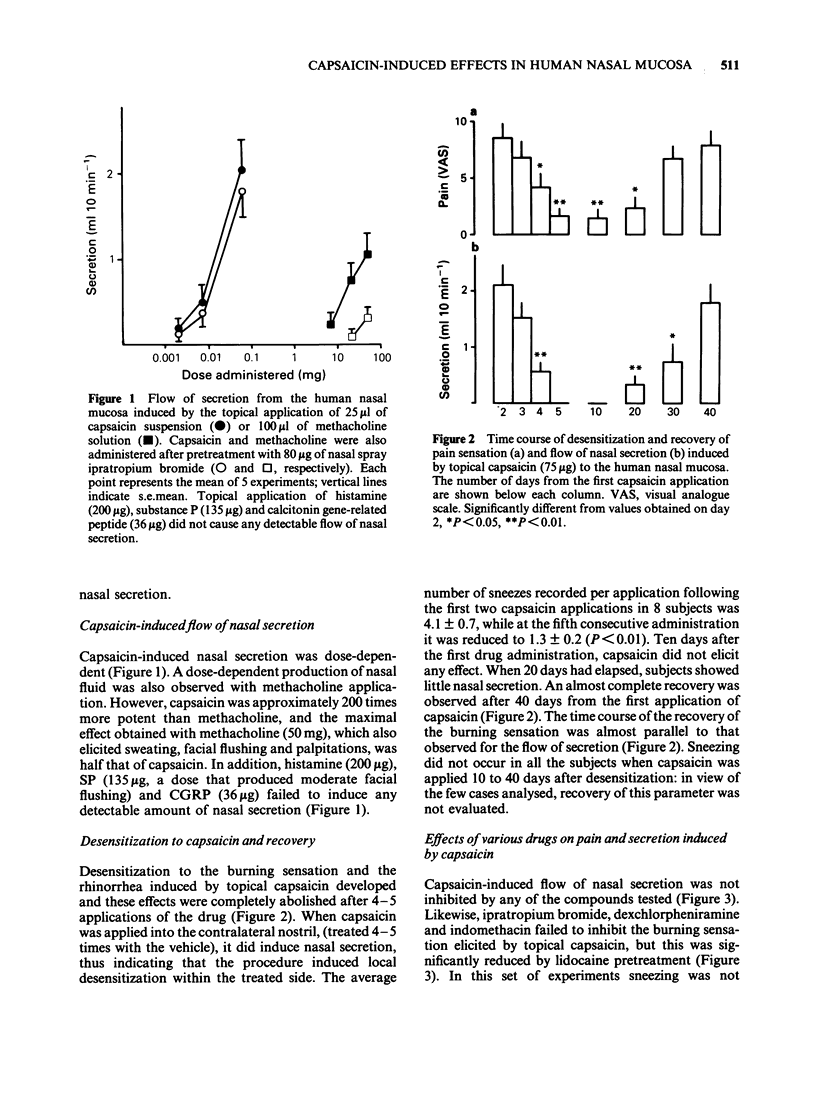
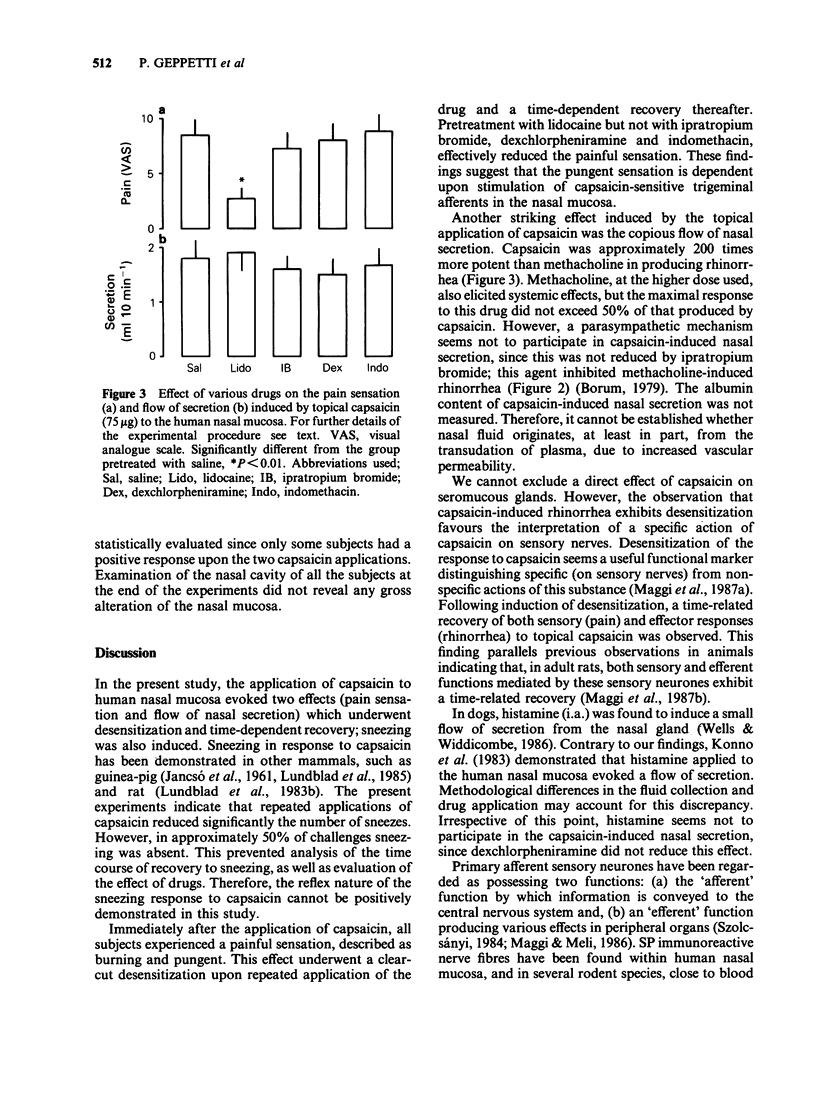
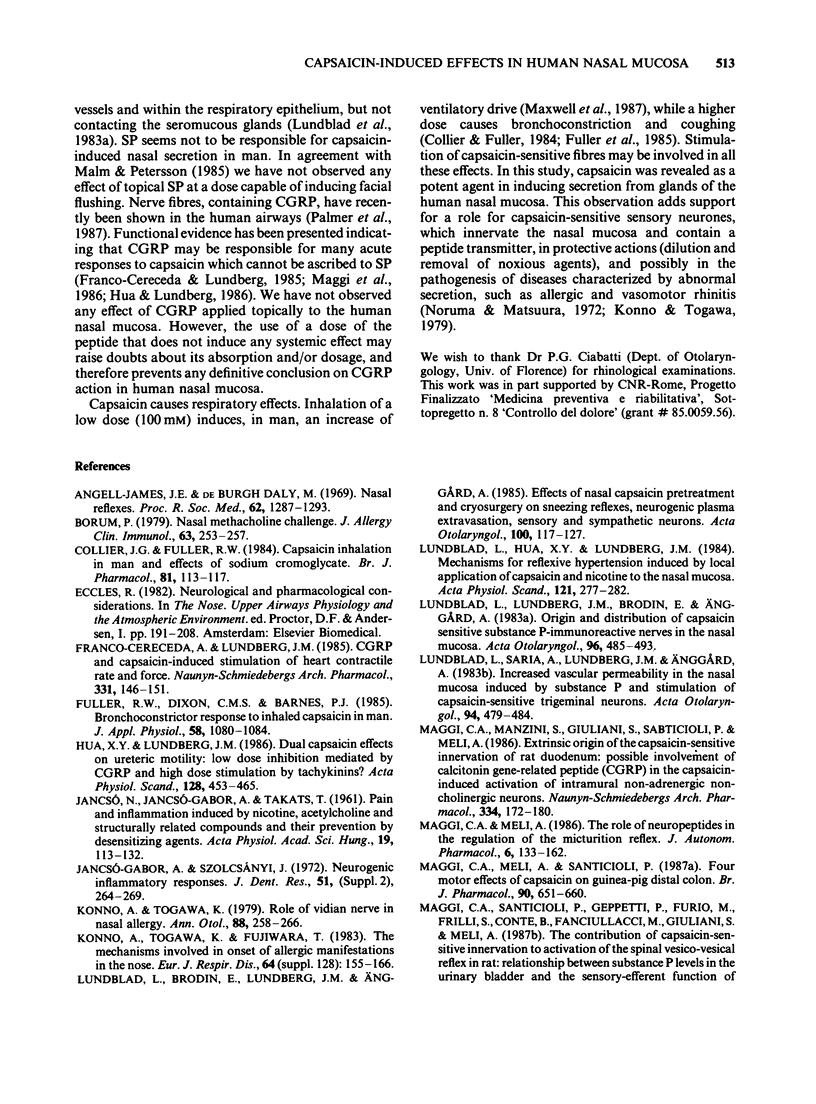
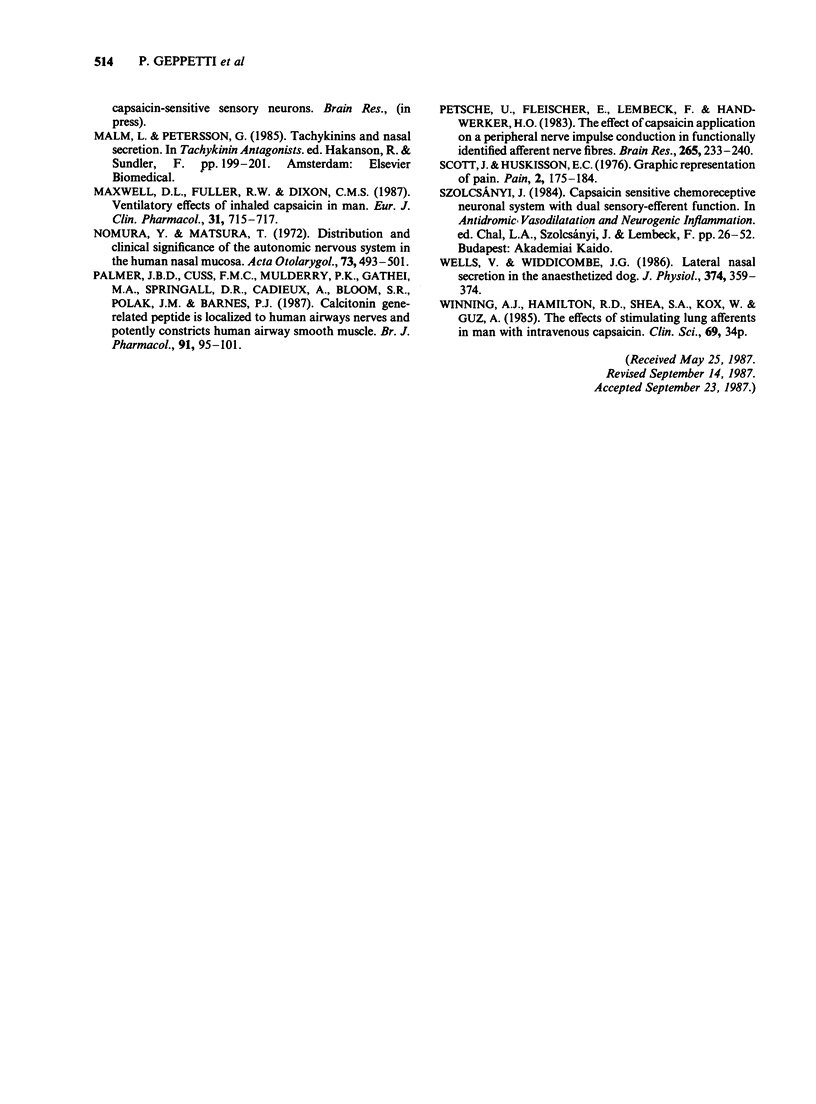
Selected References
These references are in PubMed. This may not be the complete list of references from this article.
- Angell James J. E., Daly M. de B. Nasal reflexes. Proc R Soc Med. 1969 Dec 12;62(12):1287–1293. [PMC free article] [PubMed] [Google Scholar]
- Borum P. Nasal methacholine challenge. A test for the measurement of nasal reactivity. J Allergy Clin Immunol. 1979 Apr;63(4):253–257. doi: 10.1016/0091-6749(79)90109-x. [DOI] [PubMed] [Google Scholar]
- Collier J. G., Fuller R. W. Capsaicin inhalation in man and the effects of sodium cromoglycate. Br J Pharmacol. 1984 Jan;81(1):113–117. doi: 10.1111/j.1476-5381.1984.tb10750.x. [DOI] [PMC free article] [PubMed] [Google Scholar]
- Franco-Cereceda A., Lundberg J. M. Calcitonin gene-related peptide (CGRP) and capsaicin-induced stimulation of heart contractile rate and force. Naunyn Schmiedebergs Arch Pharmacol. 1985 Nov;331(2-3):146–151. doi: 10.1007/BF00634231. [DOI] [PubMed] [Google Scholar]
- Fuller R. W., Dixon C. M., Barnes P. J. Bronchoconstrictor response to inhaled capsaicin in humans. J Appl Physiol (1985) 1985 Apr;58(4):1080–1084. doi: 10.1152/jappl.1985.58.4.1080. [DOI] [PubMed] [Google Scholar]
- Hua X. Y., Lundberg J. M. Dual capsaicin effects on ureteric motility: low dose inhibition mediated by calcitonin gene-related peptide and high dose stimulation by tachykinins? Acta Physiol Scand. 1986 Nov;128(3):453–465. doi: 10.1111/j.1748-1716.1986.tb07999.x. [DOI] [PubMed] [Google Scholar]
- JANCSO N., JANCSO-GABOR A., TAKATS I. Pain and inflammation induced by nicotine, acetylcholine and structurally related compounds and their prevention by desensitizing agents. Acta Physiol Acad Sci Hung. 1961;19:113–132. [PubMed] [Google Scholar]
- Jancsó-Gábor A., Szolcsányi J. Neurogenic inflammatory responses. J Dent Res. 1972 Mar-Apr;51(2):264–269. doi: 10.1177/00220345720510020901. [DOI] [PubMed] [Google Scholar]
- Konno A., Togawa K., Fujiwara T. The mechanisms involved in onset of allergic manifestations in the nose. Eur J Respir Dis Suppl. 1983;128(Pt 1):155–166. [PubMed] [Google Scholar]
- Konno A., Togawa K. Role of the vidian nerve in nasal allergy. Ann Otol Rhinol Laryngol. 1979 Mar-Apr;88(2 Pt 1):258–266. doi: 10.1177/000348947908800219. [DOI] [PubMed] [Google Scholar]
- Lundblad L., Brodin E., Lundberg J. M., Anggård A. Effects of nasal capsaicin pretreatment and cryosurgery on sneezing reflexes, neurogenic plasma extravasation, sensory and sympathetic neurons. Acta Otolaryngol. 1985 Jul-Aug;100(1-2):117–127. doi: 10.3109/00016488509108596. [DOI] [PubMed] [Google Scholar]
- Lundblad L., Hua X. Y., Lundberg J. M. Mechanisms for reflexive hypertension induced by local application of capsaicin and nicotine to the nasal mucosa. Acta Physiol Scand. 1984 Jul;121(3):277–282. doi: 10.1111/j.1748-1716.1984.tb07457.x. [DOI] [PubMed] [Google Scholar]
- Lundblad L., Lundberg J. M., Brodin E., Anggård A. Origin and distribution of capsaicin-sensitive substance P-immunoreactive nerves in the nasal mucosa. Acta Otolaryngol. 1983 Nov-Dec;96(5-6):485–493. doi: 10.3109/00016488309132735. [DOI] [PubMed] [Google Scholar]
- Lundblad L., Saria A., Lundberg J. M., Anggård A. Increased vascular permeability in rat nasal mucosa induced by substance P and stimulation of capsaicin-sensitive trigeminal neurons. Acta Otolaryngol. 1983 Nov-Dec;96(5-6):479–484. doi: 10.3109/00016488309132734. [DOI] [PubMed] [Google Scholar]
- Maggi C. A., Manzini S., Giuliani S., Santicioli P., Meli A. Extrinsic origin of the capsaicin-sensitive innervation of rat duodenum: possible involvement of calcitonin gene-related peptide (CGRP) in the capsaicin-induced activation of intramural non-adrenergic non-cholinergic neurons. Naunyn Schmiedebergs Arch Pharmacol. 1986 Oct;334(2):172–180. doi: 10.1007/BF00505818. [DOI] [PubMed] [Google Scholar]
- Maggi C. A., Meli A., Santicioli P. Four motor effects of capsaicin on guinea-pig distal colon. Br J Pharmacol. 1987 Apr;90(4):651–660. doi: 10.1111/j.1476-5381.1987.tb11217.x. [DOI] [PMC free article] [PubMed] [Google Scholar]
- Maggi C. A., Meli A. The role of neuropeptides in the regulation of the micturition reflex. J Auton Pharmacol. 1986 Jun;6(2):133–162. doi: 10.1111/j.1474-8673.1986.tb00640.x. [DOI] [PubMed] [Google Scholar]
- Maxwell D. L., Fuller R. W., Dixon C. M. Ventilatory effects of inhaled capsaicin in man. Eur J Clin Pharmacol. 1987;31(6):715–717. doi: 10.1007/BF00541301. [DOI] [PubMed] [Google Scholar]
- Nomura Y., Matsuura T. Distribution and clinical significance of the autonomic nervous system in the human nasal mucosa. Acta Otolaryngol. 1972 Jun;73(6):493–501. doi: 10.3109/00016487209138970. [DOI] [PubMed] [Google Scholar]
- Palmer J. B., Cuss F. M., Mulderry P. K., Ghatei M. A., Springall D. R., Cadieux A., Bloom S. R., Polak J. M., Barnes P. J. Calcitonin gene-related peptide is localised to human airway nerves and potently constricts human airway smooth muscle. Br J Pharmacol. 1987 May;91(1):95–101. doi: 10.1111/j.1476-5381.1987.tb08987.x. [DOI] [PMC free article] [PubMed] [Google Scholar]
- Petsche U., Fleischer E., Lembeck F., Handwerker H. O. The effect of capsaicin application to a peripheral nerve on impulse conduction in functionally identified afferent nerve fibres. Brain Res. 1983 Apr 18;265(2):233–240. doi: 10.1016/0006-8993(83)90337-2. [DOI] [PubMed] [Google Scholar]
- Scott J., Huskisson E. C. Graphic representation of pain. Pain. 1976 Jun;2(2):175–184. [PubMed] [Google Scholar]
- Wells U., Widdicombe J. G. Lateral nasal gland secretion in the anaesthetized dog. J Physiol. 1986 May;374:359–374. doi: 10.1113/jphysiol.1986.sp016084. [DOI] [PMC free article] [PubMed] [Google Scholar]


